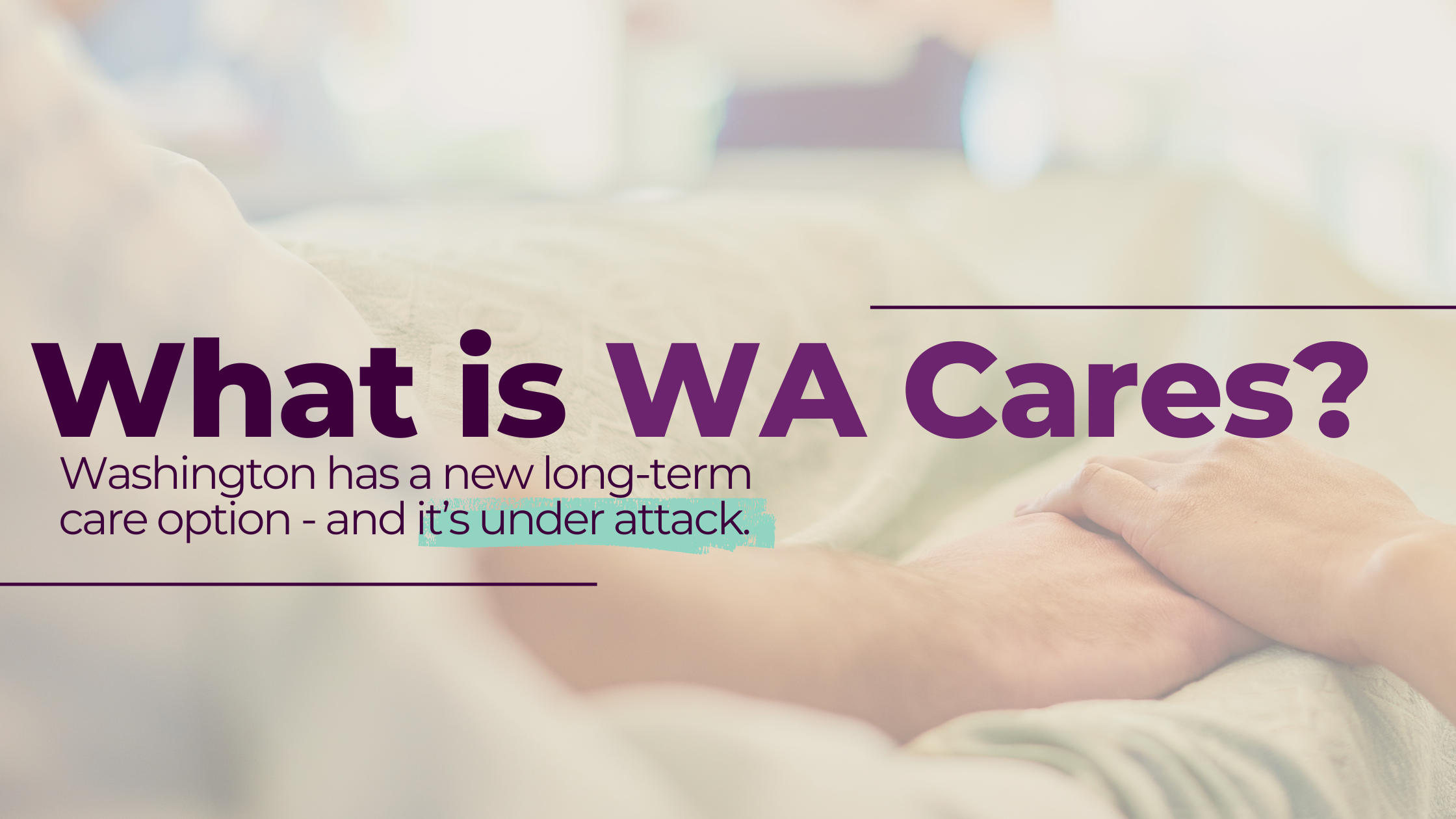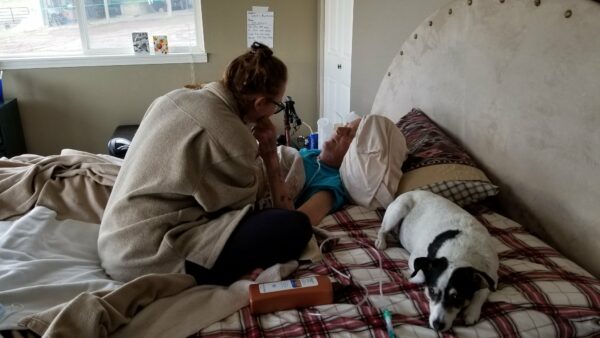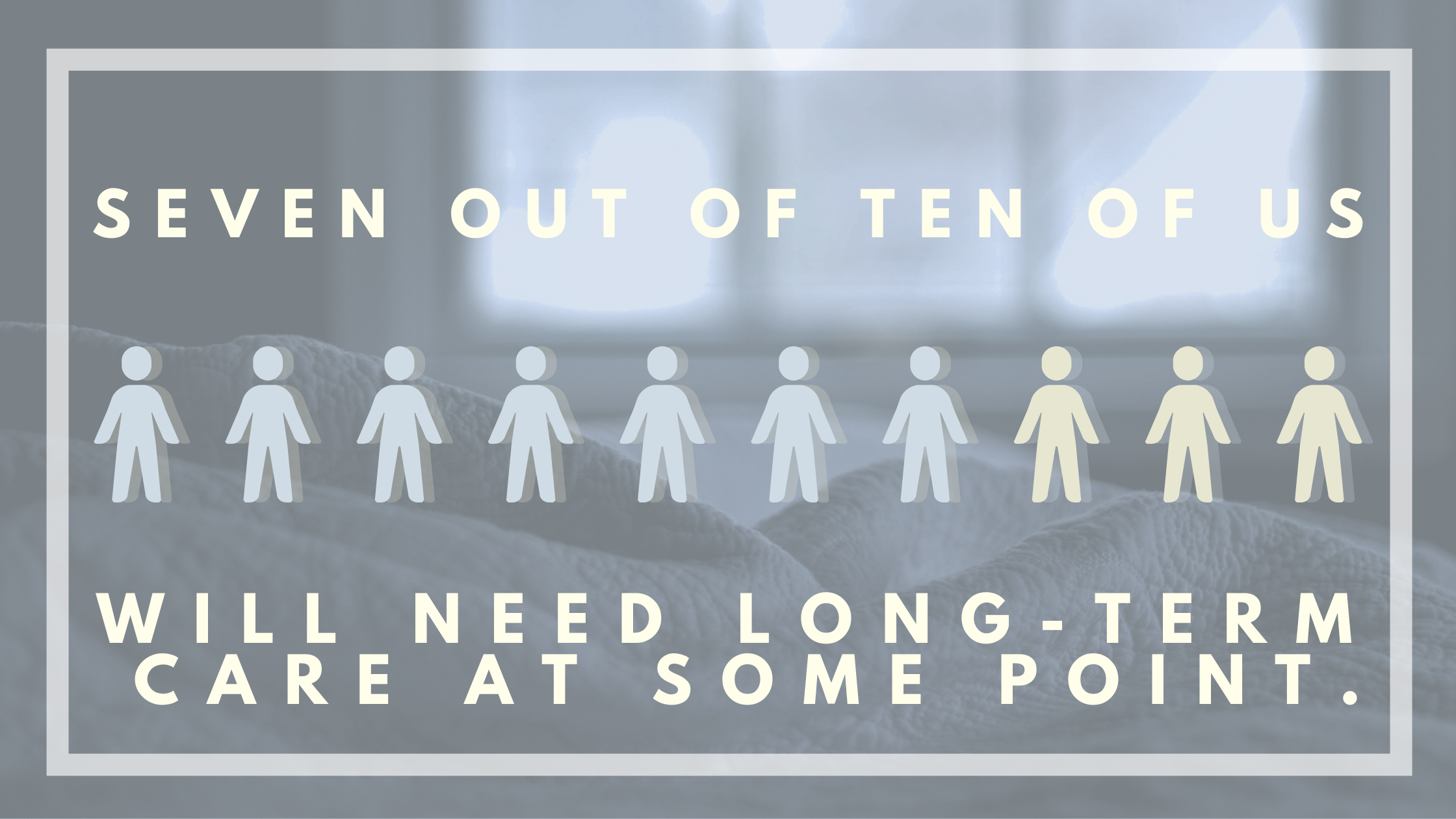
My dad was a cowboy to the end. He was able to make ends meet on his horse ranch in Eastern Washington by training horses and taking in roommates – but only when he was healthy. When his health went downhill, he needed costly full-time care. Our lives were thrown into chaos. He needed a program like WA Cares.
Unfortunately, it didn’t exist yet.
The High Cost of Care
As many people do when their parents need help, I took family leave to assist my dad. For our family, the best option was for me to temporarily live with him. That way, I could keep up the house, care for him, and connect him with services. Even after my paid leave was up, I continued to provide care throughout the next two years. I spent countless hours juggling my own schedule in order to be there for him.
That meant driving back and forth from Seattle, where I live, to his home near Spokane. It also meant that I coordinated all aspects of his medical care, as well as his financial and legal affairs.
Thankfully, during the initial crisis, I was able to take time off of work through our state’s paid family and medical leave programs. But family leave is temporary – and he needed full-time care. How in the world were we going to pay $8,000 a month for his adult family home (or $24,000 a month to help him stay at home, which was his preference)?
The truth is, in this economy, long-term care is simply not feasible for one reason or another. At least, not without government programs to help.

Sam and Dad in better days.
Long-Term Care is Often Out of Reach
Like so many in our community, my dad fell into terrible bind of need-based social services. He had some savings, but not enough to hire caregivers – and too much to qualify for Medicaid’s long-term care program.
To qualify for Medicaid long-term care, you can’t have more than $2,000 in savings as a single person, or more than $3,000 in savings if you’re married and both applying.
He didn’t have long-term care insurance, either, so we had to pay out of pocket. We ended up having to sell some of his belongings to cover costs, which put enormous strain on our family, both financially and emotionally. If he had lived much longer, he may have lost his house, as many people do when faced with the enormous costs of long-term care.
No one should be faced with these harsh realities when trying to take care of themselves and their families. Especially not in a state with so much wealth.
What is WA Cares?
This situation is not at all unique to me or my family. Across Washington State, people are making hard choices and big sacrifices to afford care for their aging or disabled loved ones.
Thankfully, Washington became the first state in the nation to pass a public long-term care (LTC) insurance program called WA Cares in 2019. WA Cares provides funds to help cover the cost when someone needs long-term care such as a home caregiver or a nursing home.
At its core, WA Cares is a safety net, like Social Security or Medicare. It’s set up to allow seniors and people with disabilities or illnesses to receive the care they need. Because traditional health insurance and Medicare don’t cover long-term care, WA Cares helps families keep their savings and prevent people from falling into poverty when they need care.
WA Cares helps cover the costs for long-term care needs such as:
- Homecare – family caregivers can be paid to help with cooking, cleaning, and grocery shopping
- Residential facilities like nursing and adult family home care
- Meal delivery services
- Equipment like wheelchairs and hospital beds
- Home modifications like installing ramps and grab bars
WA Cares is for Everyone
WA Cares covers all working Washingtonians, including part time and gig workers. Workers are eligible to receive full benefits once they have contributed to the program for 10 years and have a need for long-term care. Because the program is new, workers who are currently nearing retirement age can receive prorated benefits.
Long-term care insurance isn’t just for elders, either. Seven out of 10 people will need long-term care at some point in their lives. Of the people who currently need long-term care in the United States, 40% are under the age of 65. That means that, even if you might be healthy and independent now, it’s possible that at some point in the near future, you may need long-term care. And unfortunately, our economic system in the United States simply isn’t set up for that kind of need.
Who Pays for WA Cares?
Like Social Security, WA Cares is funded by payroll taxes from workers, who pay 58 cents per $100 of our paychecks in our working years. This doesn’t make a noticeable difference to most workers – but it does make a difference for the program itself, which started collecting premiums in July 2023 and is already preparing for its first applicants.
Beginning in 2026, Washingtonians will be able to use benefits. These benefits will start at $36,500 in the first year, and grow to $60,000 by 2046.
Why the Private Sector Doesn’t Cut It
Opponents to WA Cares believe that this is a job for the private sector – that private long-term care insurance should pay be sufficient. But as we’ve seen, that’s just not possible for most people.
A public long-term care insurance program benefits workers who don’t have the financial ability to buy a private plan or otherwise pay for long-term care. Private plans are prohibitively expensive. Until recently, they’ve only been available to a small subset of white-collar workers. As a result, only 3% of Americans over age 50 have a private LTC insurance policy. They’re just not common and most workplaces don’t encourage enrollment.
Private plans are also able to make rules that aren’t equitable or inclusive. For example, they can charge higher premiums for women. WA Cares costs the same for all workers. And unlike private LTC insurance, WA Cares won’t charge you penalties for missed payments, or deny your coverage for a pre-existing condition – something 50% of Americans experience.
These private plans will still be available to anyone who wants them. But WA Cares is providing a new option for everyone else.

Sam and Dad at home during his final days.
A Work-In-Progress
This is still a new program, which means there’s room to make changes. Advocates have been working to improve WA Cares since its original passage. So far, improvements include:
- Portability. If you pay into the program, but then move out of state (say, to retire in Florida), your benefits will follow you
- Retirees don’t pay. Once you retire, you no longer have to pay premiums, but you keep your coverage
- Benefits will rise with inflation. As inflation goes up, our benefits will keep up
- Prorated benefits for older workers. If you’re near retirement age and have only just started paying into WA Cares, you will get prorated benefits that match the amount of time you paid into the program, even if you work part-time
- Exemptions. Workers who work in Washington but live out of state may ask for an exemption
This is still a new idea, which means there are going to be tweaks. Rather than scrapping the entire program – which is what opponents are trying to do – lawmakers and advocates have the ability to improve the program as we go and ensure that it really does serve as many Washingtonians as possible.
Long-Term Care is Under Attack
If you’ve been reading the news lately, you’ve probably heard of Brian Heywood. He’s a conservative millionaire from California who is using his money to gut some of our state’s most important, most progressive programs. And he’s doing it just to save himself money.
Along with two other initiatives heading to the ballot in November, his WA Cares repeal, I-2124, would roll back our progressive long-term care. It would leave Washingtonians like my dad without care options once again.
I-2124 is bad news for Washington. The initiative would make the program an “opt-out”, which would take away $8.1 billion from the program, and quickly bankrupt WA Cares. That means it would effectively end long-term care benefits for 85% of working people.
Without WA Cares, residents would again be forced to pay out of pocket for long-term care – or be at the mercy of private companies that can deny coverage for pre-existing conditions such as cancer or diabetes.
You Can Help Save WA Cares
We are already failing our elders and others who need care in our society. We can and should do better. We’re trying to do better – and WA Cares is a key part of that puzzle.
Striking it down before it even has a chance to succeed is ridiculous and short-sighted. And for what?
You can help WA Cares by taking action. You can:
- Sign up to get updates from the campaign working to save WA Cares or become a spokesperson
- Join more than 55 organizations statewide that have signed on to oppose I-2124.
- Sign onto the Defend Washington Coalition to register your organization’s opposition to all three harmful initiatives heading to the Washington state ballot this November.
Anyone who has had a family member or friend who needed long-term care, or who has needed it themselves, knows that our system is impossibly hard. That’s why the Legislature passed WA Cares, and why we can’t let it be gutted before it’s even had a chance to help people.
More To Read
April 26, 2024
What is WA Cares and Why Does It Matter for Washingtonians?
We need to defend this important policy from billionaires looking to save a buck
April 3, 2024
Report: 87% of WA Hospitals are Falling Behind on Community Investment Requirements
Non-profit hospitals are supposed to invest in communities – but many aren’t.
February 22, 2024
Why Is Health Care Declining in Washington? Look to Hospital Consolidation
People are hurting in our state. And it’s no accident.

